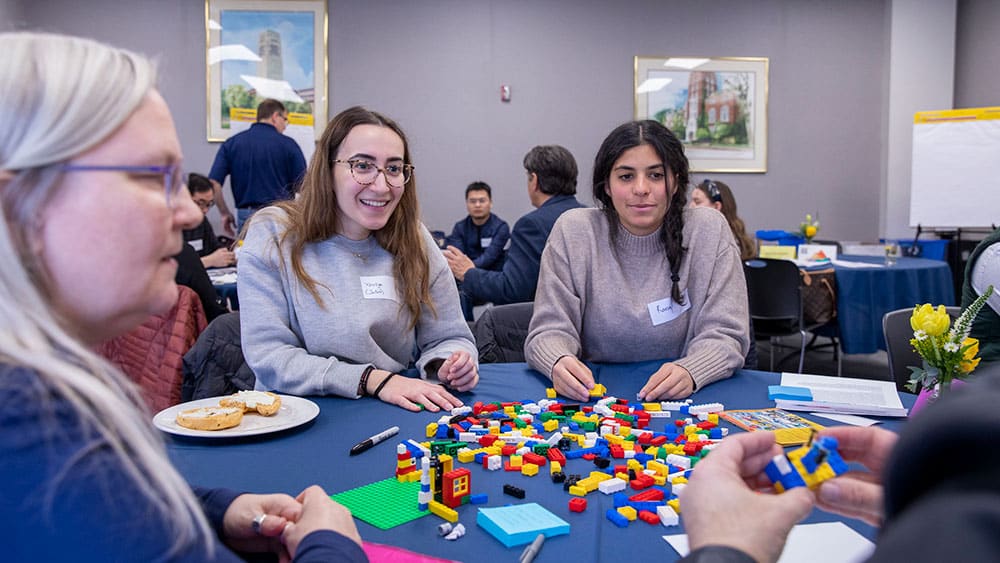Thank you to ISD students, faculty, staff, and others who joined together April 7 during the ISD DEI Action Summit: Inclusive Engineering in Practice.
During the summit, participants listened to opening remarks from Summit Moderator Dr. Alison Bailey, Lecturer, Center for Entrepreneurship; ISD Chair Dr. Diann Brei; and event organizer Dr. Miki Banu, ISD Associate Chair of Doctoral Education and Research.
Participants worked in groups to explore five real-world engineering case studies:
1. Decarbonization: Including Diversity in Sustainable Manufacturing
2. Positionality: Context for DEI, Design, and Careers
3. Electrification: Design Justice in Electrical Vehicles
4. Inclusive Thinking: Adaptive Multimodal Sensing of Thermal Comfort
5. Designing Trust in AI: Image-based AI Design for Additive Manufacturing
Lego parts and a large pad of paper were used to brainstorm and explore ways in which DEI principles can enhance engineering processes and results. The collaboration helped to identify opportunities to find solutions that have a positive impact on engineering education, research, practice, and the broader community through the lens of DEI and People-First Engineering.
ISD DEI Action Summit Details
ISD Summit Moderator

Alison Bailey, PhD
Lecturer, Center of Entrepreneurship, University of Michigan
Dr. Alison Bailey is an organizational psychologist who specializes in executive coaching, organizational development, and improving internal culture by incorporating sustainable diversity and inclusion practices into the workplace. With 20 years of senior-level human resources experience in the nonprofit field, Dr. Bailey has developed, led, and managed policies, and practices centered on career counseling, strategic planning, hiring, diversity, and inclusion. Currently, she works at a south-central Michigan hospital offering consultation, employee assistance services, and organizational development.
Bailey earned her Bachelor’s degree with honors in psychology from the University of Windsor, Master’s degree in Communication Studies from Wayne State University, and achieved her PhD from Capella University in Industrial/Organizational Psychology.
ISD Summit Speaker

Zonta Owens
Associate Consultant at Bain & Company, Chicago; Incoming MBA Student of Harvard Business School; ISD Alumni
Our guest speaker is Zonta Owens. Zonta is a recent graduate of the University of Michigan, completing his undergraduate studies in 2018 before graduating. He then moved on to obtain a Master’s in Manufacturing Engineering from ISD, which he received in 2020. He plans to pursue his Master’s of Business Administration having received early admission to the Harvard Business School, where he will start in 2024. After leaving Ann Arbor, Zonta engaged in entrepreneurship activities in the Detroit area, working with Detroit Venture Partners to support Michigan-based startups. He then went on to join Bain & Company as an Associate Consultant, where currently he works helping to manage investment portfolio strategies. Please welcome Zonta Owens.
As an associate consultant, Zonta develops analytical tools, use interpersonal, creative thinking, business management and leadership knowledge he gained as through his degrees at the University of Michigan.
Welcome home Zonta!
Case Studies
- Decarbonization: Including Diversity in Sustainable Manufacturing
- Technical Lead Daniel Cooper, Professor of Mechanical Engineering, University of Michigan
- Facilitator Shonda Adams
- Positionality: Context for DEI, Design, and Careers
- Technical Lead Nigel Melville, Associate Professor Information Systems, Stephen M. Ross School of Business, Program Director Design Science
- Technical Lead Nick Moses, ISD PhD Candidate Design Science,
- Facilitator Eric Anderson
- Electrification: Design Justice in Electrical Vehicles
- Technical Lead Art Hyde, ISD Program Director, Associate Professor of Practice,
- Facilitator Michelle Hornbacker
- Inclusive Thinking: Adaptive Multimodal Sensing of Thermal Comfort
- Technical Lead Mihai Burzo, Thompson Fellow and Associate Professor of Mechanical Engineering, University of Michigan, Flint
- Facilitator Pat Hammett
- Designing Trust in AI: Image-based AI Design for Additive Manufacturing
- Technical Lead Lei Chen, Assistant Professor, Mechanical Engineering, University of Michigan Dearborn
- Facilitator Elizabeth Mekaru
Decarbonization: Including Diversity in Sustainable Manufacturing

Plans for electric power system (EPS) decarbonization implicitly rely on massive ramp-ups in manufacturing to provide low-carbon technologies, ignoring that industry must also decarbonize if the 1.5 and 2°C climate targets are to be achieved. However, there are significant barriers both to industry ramping up at a sufficient speed to supply the EPS technologies (requiring extensive capital investments and workforce development) and to industry decarbonizing while meeting demand driven by the energy sector. Emissions modeling by the PI and others has shown that there is very little scope for increasing U.S. material stocks in any sector of the economy and still achieving industry decarbonization in line with the climate targets. Existing literature does not address this critical tension between U.S. EPS and industry decarbonization. Subsequently, EPS utilities and policymakers risk failing to decarbonize either the EPS or industry sectors. The framework devised in this proposal will identify manufacturing-feasible EPS expansion pathways that achieve absolute decarbonization in line with the climate targets. The framework will highlight the differences in the feasibility of achieving certain decarbonization pathways relative to others. Understanding differences in the feasibility of diverse pathways could transform our approach to decarbonization. While the EPS is one locus of significant investments towards a low-carbon future, deep decarbonization also requires massive infrastructure deployment across the economy (e.g., in transport) that industry must provide. The new framework could prove critical in maximizing the likelihood of successfully decarbonizing all sectors.
Question:
Considering Decarbonization – How do we assess whether potential innovations are well-scoped for the course and flexible enough to evolve as the community context changes? (Lego example: How do we integrate diversity, equity, and inclusion? How do we reduce the carbon footprint in developing communities or countries as their needs evolve and their environment changes with each season and year?

Technical Lead: Daniel Cooper, Professor of Mechanical Engineering, University of Michigan
Professor Cooper is the director of the Resourceful Manufacturing and Design group (ReMaDe) is part of the Mechanical Engineering Department at the University of Michigan. ReMaDe’s goal is to empower U.S. manufacturers to achieve sustainability through design, process, and supply chain innovations in resource efficiency, and to help foster an innovative and diverse design and manufacturing workforce to deliver those benefits.

Facilitator: Shonda Adams, ISD DEI Committee
Positionality: Context for DEI, Design, and Careers

We are all complex people with multiple identities. We may identify ourselves by our familial roles, professions, hobbies, or our aspirations. Social and political contexts inform parts of who we are. Some identities are externally visible, some aren’t as salient at times, and others are kept to ourselves.
Who you are, including all of your identities, lived experiences, life exposure, realities, truths, traumas, and thoughts, influence how you perceive everything in the world. All of these things become a lens through which everything is filtered, and we must recognize the power of the personal lens, also known as our positionality.
Positionality is the social and political context that creates your identity and how your identity influences and biases your perception of and outlook on the world. Positionality affects research, teaching, leading, policymaking, as well as common interactions.
Question:
Considering Positionality – How can we ensure that potential projects/designs are firmly grounded in the needs, desires, assets, and constraints of community partners and stakeholders? (Lego example: Positionality re-create the positionality image that includes race/ethnicity; gender; socio-economic status; ability status; age; citizenship; sexuality; religious beliefs. It can be in a square). Positionality defined: Positionality refers to how differences in social position and power shape identities and access in society.

Technical Lead: Nick Moses, PhD candidate in Design Science
My research interests include design in cross-cultural and international settings, the role of positionality in sociotechnical design, and engineering education. Currently, I am currently studying the ways and extent to which engineers consider positionality in design decisions, especially in the early stages of design. I hold a dual MS in Mechanical Engineering and Anthropology from Oregon State University, and previously worked with several organizations to design and manufacture improved institutional cookstoves in low- and middle-income countries.

Technical Lead: Nigel Melville, Associate Professor Information Systems, Stephen M. Ross School of Business, Program Director Design Science

Facilitator: Eric Anderson, ISD DEI Committee
Electrification: Design Justice in Electrical Vehicles

How can we ensure that potential projects/designs are firmly grounded in the needs, desires, assets, and constraints of community partners and stakeholders? (Lego example: what considerations are necessary when developing an Electric Vehicle (EV) to be used in Sweden and Kenya? The Lego creation would be of an EV.)
- User Empathy – the value of ensuring the diversity of users/customer/experiencers are understood and translated into use cases highlighting the un-met “needs”
- Planning & Decision-Making – the value of ensuring diverse voices/opinions/insights are mined from the leadership team in the prioritization of Goals/Requirements and the evaluation of alternate design concepts in the context of their relative risks of execution and market acceptance
- Supply-Base Development & Selection – the value of ensuring diversity in the organizations, associations, etc. selected to take significant roles in the execution in the New Product Creation process such as engineering services, subsystem co-development (full service) suppliers, traditional build-to-print manufacturing suppliers.
- Operations Management – the value of ensuring diversity in the leadership of operation facilities and team leaders for engineering, purchasing, manufacturing, assembly.
The key to Diversity “balance” starts with the context relative to the local area for cultural & ethnic norms, but must also reflect other genders, beliefs, cultures, ethnic groups, psychographic orientations and attitudes as required depending on the business goals of the organization.
Question:
Considering Electric Vehicles (EV): How can we ensure that potential projects/designs are firmly grounded in the needs, desires, assets, and constraints of community partners and stakeholders? (Lego example: What considerations are necessary when developing an EV to be used in Sweden and Kenya?)

Technical Lead: Art Hyde, ISD Program Director, Associate Professor of Practice

Facilitator: Michelle Hornbacker, ISD DEI Committee
Inclusive Thinking: Adaptive Multimodal Sensing of Thermal Comfort

Detecting human thermal discomfort can be used to reduce energy consumption in both buildings and vehicles, while automatically maintaining the thermal comfort sensation of the occupants. Using infrared thermography, video, as well as several other bio-sensors (galvanic skin response, heart rate tracker, respiration rate tracker), we record a building’s inhabitants under various thermal conditions (hot, cold, neutral), and consequently built a patented multimodal model that can automatically detect thermal discomfort. Diversity of people reate different inputs for this model which can be better trained for different conditions such as race, gender, age etc.
Based on project coordinated by Mihai G Burzo, University of Michigan, Flint, Mohamed Abouelenien, Rada Mihalcea, University of Michigan, Electrical Engineering and Computer Science
Question
Considering Detecting people thermal discomfort: How do we determine/assess whether the community partners collectively have the capacity (time and funding) to implement the project? (Lego example: Detecting human thermal discomfort can be used to reduce energy consumption in both buildings and vehicles, while automatically maintaining the thermal comfort sensation of the occupants. Using infrared thermography, video for example)

Technical Lead: Mihai Burzo, Thompson Fellow and Associate Professor of Mechanical Engineering, University of Michigan, Flint
Associate Professor of Mechanical Engineering and Frances Willson Thompson Fellow at the University of Michigan-Flint. Prior to joining Univerity of Michigan in 2013, I was an Assistant Professor at University of North Texas. My research interests include heat transfer in microelectronics and nanostructures, thermal properties of thin films of new and existing materials, multimodal sensing of human behavior, computational modeling of forced and natural heat convection. I am the recipient of several awards including the 2006 Harvey Rosten Award for Excellence for “outstanding work in the field of thermal analysis of electronic equipment”, the best paper awards at PETRA conference (2016), Semitherm conference (2013 and 2006), the Young Engineer of the Year from the North Texas Section of ASME (2006), a Leadership Award from SMU (2002), and a Valedictorian Award (1995).

Facilitator: Facilitator Pat Hammett, ISD DEI Committee
Designing trust in AI: Image-base AI Design for Additive Manufacturing

Additive manufacturing paves the way for fabricating customized, complex structures, thus enabling numerous applications in aerospace, automobile and biomedical sectors. The design of biomedical materials and/or devices nowadays allows for unprecedent freedom for improved mechanical and biological properties. Image-based artificial intelligence (AI) can be used to design custom orthopedic implants for additive manufacturing, with full respect to diversity of patients (e.g., gender, age, bone conditions). Using AI trained with biostructure images, we can design implants with target properties via AI-enabled high-throughput screening. Different implants with tailored structures and properties have been designed towards matching these of natural bones of different patients.
Based on the research by Miki Banu, Zhuo Wang, Rana Dabaja, University of Michigan, Mechanical Engineering, Lei Chen, University of Michigan-Dearborn, Mechanical Engineering
Question:
Considering Designing trust in AI: How do we assess whether community partners collectively have the capability (knowledge, skills, relationships, etc.) to implement potential projects? (Lego example: embedding diversity in AI tools. Create an AI image that would embed diversity, such as the facial recognition technology for smartphones for black and brown faces; a robot).

Technical Lead: Lei Chen, Assistant Professor, Mechanical Engineering, University of Michigan Dearborn
Dr. Lei Chen joins the University of Michigan-Dearborn from Mississippi State University. His research interests are in the broad area of advanced manufacturing and materials design by combing physics models, experiments and artificial intelligence. Dr. Chen has published over 100 papers in top international journals including Nature, Nature Communications, Advanced Materials, Advanced Energy Materials, Acta Materialia, Additive Manufacturing, etc. and has received several awards, the most recent of which are the prestigious ASEE Southeastern Section New Researcher Award (2018) and ORAU Ralph E. Powe Junior Faculty Enhancement Award (2017).

Facilitator: Elizabeth Mekaru
DEI Best practice from IDEAS DEI Summit 2022
- Advance equity: Be transparent to stakeholders and include them early in decision making process.
- Power of differentials: Integrate marginalized people, co-designers, different mindsets or perspectives in the design act.
- Reconcile diversion points: Reflect on your values and be intentional and inclusive.
- Bold in self-reflection: Integrate and verify if it is equitable and fair a project/development through analyzing the society impact.
- Self awareness: Make space for people to express their option and increase the level of engagement. Example: Male dominated situations.
- Sameness: Drive strategic diversity through integrative thinking.
- Design impact strategies: How to quantify the diversity of contextual factors. Power dynamics: Include an equitable representation of the cultural dimensions.
- Team compositions: Engineering efforts must incorporate different perspectives, beliefs and create knowledge on understanding of integration.
- Contextual factors: Implement DEI from the most granular to the most macro level of the system so that the system can be heralded as developed and designed for DEI.
